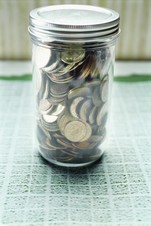The Emergency Fund
How many times have you wished you had an emergency fund in place when life throws its little surprises your way?

The car breaks down…the water heater goes out…someone has to go to the emergency room…or a breadwinner loses a job.
All of these circumstances, and a thousand others, can lead us straight into financial distress, especially if we’re living paycheck to paycheck (which most of us are).
We know that things like this will happen to everyone from time to time. We must be prepared! Going into debt to pay for these emergencies will only cause more financial problems down the road. We need a solution that will not create more stress in an already stressful situation. We need a solution that will bring a feeling of security in a time of uncertainty!
It’s time to get that
Emergency Fund in place!
The Two-Phase Plan
Phase One: $1000 in the bank
Your first goal is to get $1000 in the bank to begin your emergency fund. This won’t suffice if your household loses significant income, but it will help with the smaller emergencies. It’s a good starting point.
Where will the money come from? Depending on your financial situation, you may have to really make some sacrifices to get this done. For others, it may just mean cutting back on eating out and going to the movies.
Start by selling things you have around the house. Use Ebay or have a yard sale. Most families have a lot of things they could live without. As says,
Dave Ramsey
“Sell so much stuff that the kids think they’re next!”.
Another way to come up with the money is to get extra work. Side jobs are a great way to bring in extra cash. Babysitting, mowing lawns, cleaning houses, offices, or even construction sites, sewing, ironing, weekend building or remodeling jobs, painting-use your imagination. What skills do you have that you can use to bring in extra money? The possibilities are endless!
Part-time jobs are always a successful means of income. You’re not too good to deliver pizzas or newspapers! How badly do you want to have financial security for your family? It’s all a matter of priorities!
Phase Two: 3-6 Months Income
The second phase of your emergency fund is to complete your fund with 3-6 months of income. This is important to have in place in the event that a job is lost or someone becomes disabled and can’t work.
Phase Two doesn’t begin, however, until you’ve got all of your debt paid off (except for the mortgage). It would be too hard to come up with the amount of money needed to complete your fund while you’re still paying all those credit card bills and car payments.
Once you’ve got that debt paid off, start putting all of the money that you have been paying on your debt snowball towards your emergency fund. Don’t cheat on this! If you’re really following the plan, you don’t have the credit cards to fall back on now. You must get this fund completed!
For most people, this completed fund will have $10,000-$15,000.
You want to keep this money in a money market account with your local bank, so it will be easy to access if you need it for an emergency. Don’t put it in a CD or some other investment account that will charge you fees if you take it out early.
You’re not using this money as an investment. This money is insurance!
Last Rule: Only use your emergency fund for emergencies! That really cute outfit that you found on sale is NOT an emergency. Keep your priorities in place! It’s worth it!
Family Budget|
Cash Budget Envelope System
Bill Paying System|
Debt Snowball|
Saving For Retirement
Subscribe to "The Calm Mom" Newsletter
Leave Emergency Fund Page and Go Back to My Finances Page






